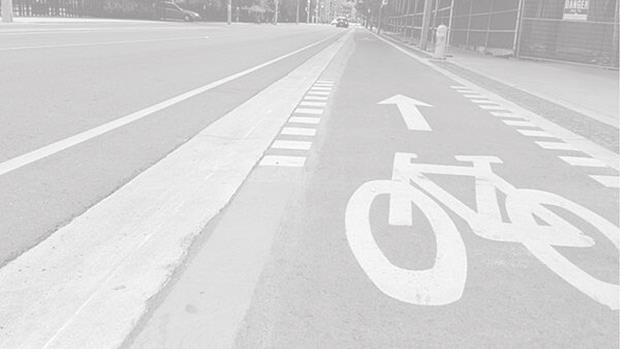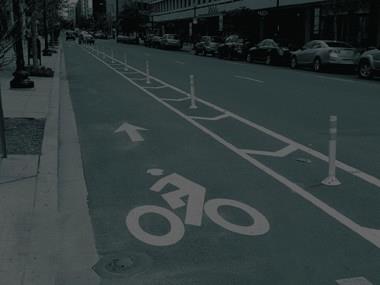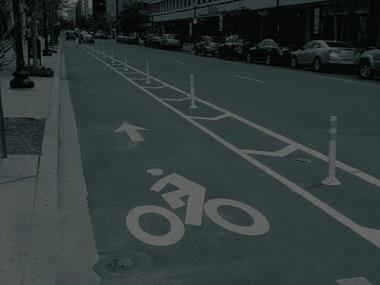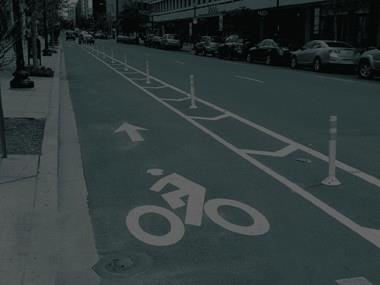Maru/vcr&c proposal



Cycling Poll, 2016
MARU/VCR&C via the
Measuring Torontonians' interest in
a Safer Cycling Network
This research was commissioned by Evergreen in partnership with Cycle Toronto,
Toronto Centre for Active Transportation, and the Metcalf Foundation.
• Background & Methodology• Support for the "Safer Cycling Network"• Needs assessment: urgency for cycle infrastructure• Perceived Benefits:
— Safety— Enablement of cycling— Diversification of transportation options

Objectively measure interest in a Toronto-wide cycling network among a representative cross section of Toronto.
Torontonians, 18+/
Representative by age, gender and region according to Statistics Canada.
Data weighted to age, gender, and borough by 2011 census.
Sample Size
Torontonians were surveyed between April 22nd and May 2nd, 2016Survey fielded on the Angus Reid Forum. The survey results are accurate within 2.4% 19 times out of 20.
Steps taken to ensure utmost data integrity:• Representative:
— The results are representative of age, gender, and population size by borough according to census. Sample was both balanced at
invitation outgo, as well as weighted upon completion.
— The survey invitation was sent blinded. There was no mention of cycling or anything related in the subject line, invitation, or prior
to introducing the subject matter.
• Industry Leading Sample Quality:
— The Angus Reid Forum panel was used to field the study. It is known for in-depth profiling and rigorous quality control with
minimal panel pollution and fatigue.
— Angus Reid Forum uses a multi-pronged recruit strategy to gather a diverse and engaged cross-section of the population with a
focus on quality rather than quantity. Angus Reid is a household name in Canada so many of our panelists (about 11%) simply
— Our Panelists remain engaged both during and in-between surveys. We send monthly newsletters featuring recent poll highlights
and news results as well as offering incentives to build interest and maintain participation.
— We have a tighter definition of what constitutes an ‘active' member than the industry standard. An ‘active' member for our Voice of
Market communities is defined as a someone that has participated in at least one survey or updated his/her profile, or registered
to join the panel within the last 5 months (the proposed ISO standard suggests 12 months).
— We have correctly predicted the results of 17 consecutive Canadian and US regional and national elections with a higher level of
accuracy than all our competitors. Elections are one of the few occasions in which research findings are tested against real
outcomes. The Canadian panel specifically was vetted by the Grand Mean test through MKTG. Inc and proven to be of the
highest quality,
— The research was conducted by MARU/VCR&C's Public Affairs consulting division which is a global company headquartered in
Toronto. MARU/VCR&C, formerly the Research & Consulting division of Vision Critical, is a professional services firm that helps
its clients improve business outcomes by being more empathetic to their customers. We deliver our services through teams of
sector-specific research consultants that have technology in their DNA, specializing in the use of Insight Community technology.
Our research drives decision making across all aspects of customer experience, including innovation, product, branding,
commercialization and communications.
— The research was led by Lucas Melbye, Research Director, and Yasmin Omidvar, Sr. Research Manager.
Sample Profiling*
Old Toronto
North York
East York
(Weekly to Daily)
50% of Torontonians have
ridden a bicycle at least
once in the past year. These
(Bimonthly to Monthly)
are defined as ‘cyclists' for
the sake of this report.
*Sample weighted to age, gender, and borough of Toronto. Outgo balanced.
TRANSPORTATION_MODES. In good weather, how frequently do you use each of the fol owing modes of transportation: Cycling?
CYCLIST. Have you ridden a bicycle at least once in the last year?
Support for the "Safer Cycling Network"
What is the "Safer Cycling Network"?
Safer Cycling Network: An inter-connected series of bike lanes, cycle tracks, multi-
use trails, and shared roadways in Toronto which would provide seamless access to
different parts of the city. It is not limited to just the downtown core and would
also include North York, Etobicoke, and Scarborough. This network was started in
2001 but is far from complete, especially outside of downtown. The goal of the City
of Toronto's new Cycling Network Plan is to fill in the gaps, add more routes, and
enhance existing routes.

of Torontonians are
"strongly" or "mostly"
in favour of the idea
of the safer cycling network
Base: All Respondents (n=1603)
QSUPPORT. Based on the description provided, which of the following best describes your support for the idea of a "Safer Cycling Network".

90% "Even though I
bicycle, I recognize
the role they can
play in reducing car
81% traffic on our roads."
Strongly/mostly in favour of the idea…
Among Non-Cyclists
Base: All Respondents (n=1603) Cyclists (n=778), Non-cyclists (n=825).
QSUPPORT. Based on the description provided, which of the following best describes your support for the idea of a "Safer Cycling Network".

86% Scarborough 88%
Strongly/mostly in favour of the idea…
Base: All Respondents (n=1603) East York (n=97), Etobicoke (n=172), North York (n=281), Scarborough (n=245), Toronto (n=703), York (n=105)
QSUPPORT. Based on the description provided, which of the following best describes your support for the idea of a "Safer Cycling Network".
The reasons for support / opposition are multi-
dimensional. Easing congestion is key for both.
Reasons for Supporting or Opposing
"Why I Support the Network"
"Why I Oppose the Network"
"Takes too much of the
"If there were safer cycling
Improving safety will
road which will cause
routes, a lot more people
more traffic congestion
would cycle, getting more
because the cars have
cars off the road."
"Half the year is cold. it
"More bikes = fewer cars =
takes up car lanes and
The weather does
better traffic movement."
wouldn't be used half the
"Cycling is environmentally
"It is dangerous to have
friendly; let's make it safe
Unsafe for cyclists
cyclist on the road with the
and encourage more
people to cycle."
"Toronto needs more ways
"ALL cyclists need to be
licensed and insured. If they
want to be on the roads, they
Torontonians need
"It fills the transit gaps"
need to follow they same rules
that I have to, by law. "
Base: Al Respondents (n=1603)
QSUPPORT_WHY. What makes you ["favour" or "oppose"] the idea of a Safer Cycling Network? Open ended.

The need for infrastructure is urgent and felt by non-
68% Etobicoke 61%
(Strongly Agree/Agree)
The City of Toronto needs to create better
Among Non-Cyclists
bike infrastructure urgently
Base: Al Respondents – Total (n=1603); Cyclist (n=778), Non-Cyclist (n=825), East York (n=97), Etobicoke (n=172), North York (n=281), Scarborough (n=245),
Toronto (n=703), York (n=105)
QCYCLE_ATTITUDES. Please indicate how much you agree or disagree with the fol owing statements in the context of cycling in Toronto.
There is an immediacy underlying the demand
64% "I see this as something
that may move swiftly
towards safe biking for the
city. The delay in
everything, all the time, I
(Strongly Agree/Agree)
find frustrating, so tend to
(A Safer Cycling Network…) is something I want to
become disengaged."
see built immediately
Base: Al Respondents – Total (n=1603)
QSUPPORT_ATTITUDES. Please indicate how much you agree or disagree with the fol owing statements. A "Safer Cycling Network" .
What level of funding is most appropriate?
The City of Toronto currently
spends $336 Million dollars
per year on Transportation.
Out of that budget, which do
you feel is the most
appropriate level of
spending per year for the
"Safer Cycling Network"?
The majority of Torontonians want increased
investment in cycling
Most Appropriate Investment: Safer Cycling Network
2.4% the current level per year.
Wil complete the network in 19 years
67% of Torontonians feel an
investment of 4.8% or more
3.6% to complete the network in 13 years
in a timeframe of 9 years or
less is appropriate
4.8% to complete the network in 9 years
7.5% to complete the network in 6 years
to complete the network in 3 years or less
Base: Al Respondents (n=1603)
QINVESTMENT_LEVEL_NETWORK. The City of Toronto currently spends $336 Mil ion dol ars per year on Transportation. Out of that budget, which do you feel is the most
appropriate level of spending per year for the "Safer Cycling Network"?
Alleviating safety concerns
It is widely acknowledged that cyclists need better
protection from vehicles
transportation is
entitled to a safe
(Strongly Agree/Agree)
Cyclists need better protection from
motor vehicle traffic in Toronto
Base: Al Respondents – Total (n=1603)
QCYCLE_ATTITUDES. Please indicate how much you agree or disagree with the fol owing statements in the context of cycling in Toronto.
Torontonians perceive the Network as a way to
That a Safer Cycling Network would reduce
fatalities from car/bicycle collisions.
That a Safer Cycling Network would make Toronto's
roads safer for all
Base: Al Respondents – Total (n=1603)
QSUPPORT_ATTITUDES. Please indicate how much you agree or disagree with the fol owing statements. A "Safer Cycling Network" .
There is near unanimous support for the idea of
Support for Ending Traffic Fatalities
Somewhat support% Support*
Cycling is a great
environmental y friendly
way of getting around
town, but it's currently very unsafe in a lot of
areas. There are
always cyclists getting
seriously injured or
kil ed by vehicles. "
Significantly higher
Base: Al Respondents – Total (n=1603); Cyclist (n=778), Non-Cyclist (n=825); East York (n=97), Etobicoke (n=172), North York (n=281), Scarborough (n=245), Toronto (n=703), York
QTRAFFIC_FATALITIES. Which of the fol owing describes your feelings towards a City of Toronto decision to adopt the goal of eliminating traffic fatalities and serious injuries?
Reducing barriers to enable cycling
There is an opportunity to enable Torontonians to
seamless route limits
my wil ingness to
cycle more often. I do
(Strongly Agree/Agree)
not want to be fighting
I wish I could ride my bicycle more often
for space and right of
than I currently do
way with vehicles"
Base: Al Respondents – Total (n=1603)
QCYCLE_ATTITUDES. Please indicate how much you agree or disagree with the fol owing statements in the context of cycling in Toronto.
More than half of cyclists do not like riding in traffic
and will only do so separated from traffic or on low
Riding Comfort Levels
I don't like riding in
" ersonally don't
traffic and will only
ride on low speed
ride on the streets
roads, or separated
I'm comfortable in
traffic but prefer
Base: Cyclist – Total (n=778)
QCYCLE_PATH_PERSONA. Which of the fol owing best describes you as a cyclist?
Cycling as a means of transportation
Getting Toronto moving is about leveraging all four
modes of transportation, especially transit
How much do you agree or disagree that the
following are ways to get Toronto moving?
% Strongly Agree/Agree
Base: Al Respondents (n=1603)
Q_MOVING. How much do you agree or disagree that the fol owing are ways to get Toronto moving?
Cycling is a means of diversifying transportation
options for Torontonians
That more bicycle lanes physically separated from
motor-vehicles would make traffic move better
That a Safer Cycling Network is an important way to
get Toronto moving faster
61% (Strongly Agree/Agree)
That a Safer Cycling Network would alleviate
crowding on the TTC
Base: Al Respondents – Total (n=1603)
QCYCLE_ATTITUDES. Please indicate how much you agree or disagree with the fol owing statements in the context of cycling in Toronto. QSUPPORT_ATTITUDES. Please
indicate how much you agree or disagree with the fol owing statements. A "Safer Cycling Network" .
• There is broad support for the idea of the "Safer Cycling Network":
— 86% in favour— Support for the Network is consistently high across boroughs (the lowest
level of support being Etobicoke at 79%)
• Accelerated funding feels appropriate for a majority of Torontonians:
— 67% of Torontonians feel an investment of 4.8% or more per year in a
timeframe of 9 years or less is appropriate.
• The benefits are multi-dimensional:
— Increased safety— Enabling Torontonians to cycle more— Diversification of transportation options
Research Director MARU/VCR&C
direct +1.416.642.2085 / mobile +1.647.209.1626
Most Torontonians use more than one mode of
transportation to get around
Transportation Mode Used (in good weather)
Frequently = Almost weekly to daily
frequently use transit
Base: Al Respondents (n=1603);
QTRANSPORTATION_MODES. In good weather, how frequently do you use each of the fol owing modes of transportation?
Source: https://www.cycleto.ca/sites/default/files/Angus-Reid-Forum-Cycling-Poll-May-2016.pdf
Dossier Scientifique Protection hépatique A.I / Synthèse des effets hépatoprotecteurs de la phosphatidylcholine (constituant physiologique des membranes) RÉTABLISSEMENT DE L'INTÉGRITÉ STRUCTURELLE ET FONCTIONNELLE DES MEMBRANES A.2 / Cytochrome P450 2E1 : de la stéato-hépatite alcoolique (ASH) à la stéato-hépatitenon-alcoolique (NASH). (Lieber, Hepatol Res 2004) (revue)
Ayurveda for Her Karta Purkh Singh Khalsa, R.H., C.D.-N. November 1, 2002 Ayurveda, the ancient holistic healing system of India, is a complete approach to health and lifestyle management. This system incorporates diet, exercise, life activityroutines, psychotherapeutic practices, massage, and, of course, botanical medicine, whichis the foundation of Ayurvedic therapeutics.








